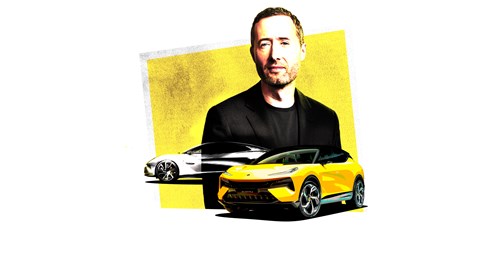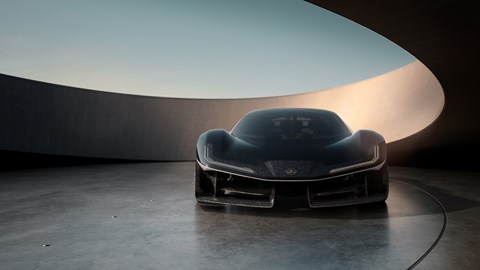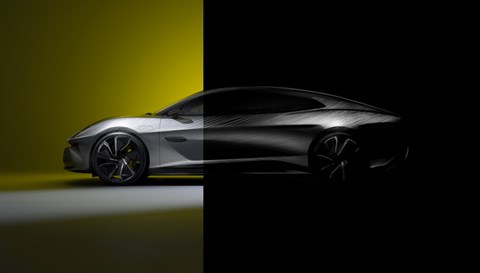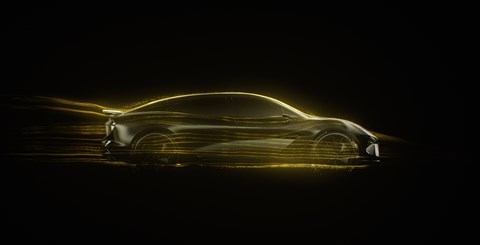► We speak to Lotus Group design VP Ben Payne
► What’s next for Lotus
► How to make the brand work globally
There was an interesting slide projected at a recent Lotus press briefing ahead of its proposed IPO listing on the NASDAQ stock exchange. It reiterated the British brand’s well-publicised ‘all electric from now on’ product introductions and latest delivery schedules, it also gave some extremely ambitious sales estimates and pricing information.
Lotus wants to sell 5000-6000 Emira combustion sports cars in 2024. And 40,000-50,000 £89,500-plus Eletre large SUVs per year from 2026. Plus 30,000-40,000 similarly-priced Emeya GTs, and a whopping 80,000-90,000 £55k-plus mid-sized SUVs (Type 134) a year from 2027. Add in 10,000-15,000 annual sales of the Type 135 sports car at circa £75,000, plus the odd £2m-ish Evija hypercar, and the annual total could top 200,000 units and a lot of revenue. By comparison, Porsche sold 320,221 cars in 2023. Given that Lotus sales were under 1000 in 2022, that’s a monumental ramp-up.

All of which makes new Lotus Group design VP Ben Payne’s job an increasingly large and complex one. The 45-year-old took on the top job in August 2023, just months after the untimely death at 73 of his former boss, the veteran Peter Horbury.
‘The strategy was set regarding future products,’ Payne says. ‘Peter contributed to them, so his legacy will be felt for quite a few years.’ Payne was already chief creative officer of the Lotus Tech Creative Centre in Coventry by 2022 (overseeing the non-sports car side of the range) and boasts a long career to date. The Royal College of Art graduate has worked at Bugatti (2009 16C Galibier concept), Aston Martin (2016 DB11) and for numerous global car brands during two stints at design agency Makkina. He joined Lotus owner Geely in 2018.

He’s keenly aware of the leap ahead. ‘We have to shape the brand so it works everywhere,’ he says. ‘Our 2022 sales figures were some 600 cars, and now we’re getting on for 19,000 orders. Those customers are very different, but we’ve got to not leave people behind. As we start to release smaller vehicles, maybe they will be easier for that [existing] audience to accept. “Lighter and tighter” technological products are a brand-level aspiration. But it’s driven by what we can offer customers at the right price point. You can make smaller, more tightly-packed, higher-tech cars – but they are expensive.’
Payne is alluding to the next two smaller Lotus EVs. First up is the Type 134 mid-sized SUV, due to be unveiled later in 2024 and take on the newly-electric Porsche Macan in showrooms by 2026, and second, the Type 135 two-seat sports car to be revealed in 2025 and on sale 2027.

‘When you’re stretching the brand most people know from the Elise, the Eletre is a big transition,’ he continues. ‘But we’ve got more freedom with the Type 134.’ So, no mini-me Eletre then? ‘I think as we take what the brand represents – that real pioneering spirit – you can expect more of a statement.’ Sounds promising.
Payne also keeps an eye on every area a Lotus logo touches. For starters, I half-jokingly suggest he takes a look at the London showroom’s weirdly black loo paper and narrow downlighting in the rest rooms. ‘Designers sometimes get too into the details, trying to harmonise things and be consistent,’ he concedes. ‘Otherwise people can run too fast and the brand becomes diluted. But, note to self, “sort the toilets out”…’

More seriously, he reports directly to Lotus CEO Qingfeng Feng and is acutely aware of the increased weight of the Lotus EV line-up at odds with its founder Colin Chapman’s famous ‘simplify, then add lightness’ mantra. ‘Weight is a massively important factor in vehicle efficiency so just saying “I’m an EV and I’m green” doesn’t tick all the boxes. You need to be heading towards circularity, in the way you design and create as the product goes through its lifecycle. That is the aspiration everyone needs to chase and that will be driven by certain markets quicker than others.
‘The second part of the equation is brand value. What’s the right thing for Lotus to do? To make cars which are as efficient as possible in any segment. That comes back to materials and manufacturing. Massively so.’